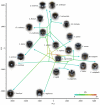Character displacement of Cercopithecini primate visual signals
- PMID: 24967517
- PMCID: PMC4110701
- DOI: 10.1038/ncomms5266
Character displacement of Cercopithecini primate visual signals
Abstract
Animal visual signals have the potential to act as an isolating barrier to prevent interbreeding of populations through a role in species recognition. Within communities of competing species, species recognition signals are predicted to undergo character displacement, becoming more visually distinctive from each other; however, this pattern has rarely been identified. Using computational face recognition algorithms to model primate face processing, we demonstrate that the face patterns of guenons (tribe: Cercopithecini) have evolved under selection to become more visually distinctive from those of other guenon species with whom they are sympatric. The relationship between the appearances of sympatric species suggests that distinguishing conspecifics from other guenon species has been a major driver of diversification in guenon face appearance. Visual signals that have undergone character displacement may have had an important role in the tribe's radiation, keeping populations that became geographically separated reproductively isolated on secondary contact.
Figures




Similar articles
-
A new species of fossil guenon (Cercopithecini, Cercopithecidae) from the Early Pleistocene Lower Ngaloba Beds, Laetoli, Tanzania.J Hum Evol. 2022 Feb;163:103136. doi: 10.1016/j.jhevol.2021.103136. Epub 2022 Jan 13. J Hum Evol. 2022. PMID: 35033736
-
Assessing the potential information content of multicomponent visual signals: a machine learning approach.Proc Biol Sci. 2015 Mar 7;282(1802):20142284. doi: 10.1098/rspb.2014.2284. Proc Biol Sci. 2015. PMID: 25652832 Free PMC article.
-
The structure of species discrimination signals across a primate radiation.Elife. 2020 Jan 13;9:e47428. doi: 10.7554/eLife.47428. Elife. 2020. PMID: 31928629 Free PMC article.
-
Occam's razor revisited: guenon species morphology supports evidence for an African influence in Bronze Age Aegean fresco primate iconography from Akrotiri, Thera.Primates. 2021 Sep;62(5):703-707. doi: 10.1007/s10329-021-00930-w. Epub 2021 Jul 7. Primates. 2021. PMID: 34232418 Review.
-
[Comparative studies of face recognition].Brain Nerve. 2012 Jul;64(7):793-8. Brain Nerve. 2012. PMID: 22764351 Review. Japanese.
Cited by
-
Does facial hair greying in chimpanzees provide a salient progressive cue of aging?PLoS One. 2020 Jul 14;15(7):e0235610. doi: 10.1371/journal.pone.0235610. eCollection 2020. PLoS One. 2020. PMID: 32663207 Free PMC article.
-
Periodic patterns in Rodentia: Development and evolution.Exp Dermatol. 2019 Apr;28(4):509-513. doi: 10.1111/exd.13852. Epub 2019 Jan 15. Exp Dermatol. 2019. PMID: 30506729 Free PMC article.
-
Skull variation in Afro-Eurasian monkeys results from both adaptive and non-adaptive evolutionary processes.Sci Rep. 2022 Jul 22;12(1):12516. doi: 10.1038/s41598-022-16734-x. Sci Rep. 2022. PMID: 35869137 Free PMC article.
-
Mosaic evolution and the pattern of transitions in the hominin lineage.Philos Trans R Soc Lond B Biol Sci. 2016 Jul 5;371(1698):20150244. doi: 10.1098/rstb.2015.0244. Philos Trans R Soc Lond B Biol Sci. 2016. PMID: 27298474 Free PMC article.
-
Consequences of Hybridization in Mammals: A Systematic Review.Genes (Basel). 2021 Dec 24;13(1):50. doi: 10.3390/genes13010050. Genes (Basel). 2021. PMID: 35052393 Free PMC article.
References
-
- Pfennig DW, Pfennig KS. Evolution’s Wedge: Competition and the Origins of Diversity. University of California Press; 2013.
-
- Coyne J, Orr H. Speciation. Sinauer Associates; 2004.
-
- Ortiz-Barrientos D, Grealy A, Nosil P. The genetics and ecology of reinforcement: implications for the evolution of prezygotic isolation in sympatry and beyond. Ann. N. Y. Acad. Sci. 2009;1168:156–82. - PubMed
-
- Brown WL, Wilson EO. Character displacement. Syst. Zool. 1956;5:49–64.
-
- Richards-Zawacki CL, Cummings ME. Intraspecific reproductive character displacement in a polymorphic poison dart frog, Dendrobates pumilio. Evolution. 2011;65:259–67. - PubMed
Publication types
MeSH terms
Grants and funding
LinkOut - more resources
Full Text Sources
Other Literature Sources

